Mashed potatoes should never be bland, lumpy, or gummy. With this recipe, they never will be. This recipe gives you that rich, creamy texture everyone loves, thanks to just the right mix of cream cheese, butter, and buttermilk.
For gravy of any variety, check out my ultimate guide to homemade gravy.

Why My Recipe
- Uses the perfect ratio of cream cheese, butter, and buttermilk for ultimate creaminess.
- Cooked in chicken broth for built-in flavor before any seasoning is added.
- No more gummy or lumpy potatoes. This technique guarantees creamy potatoes every time.
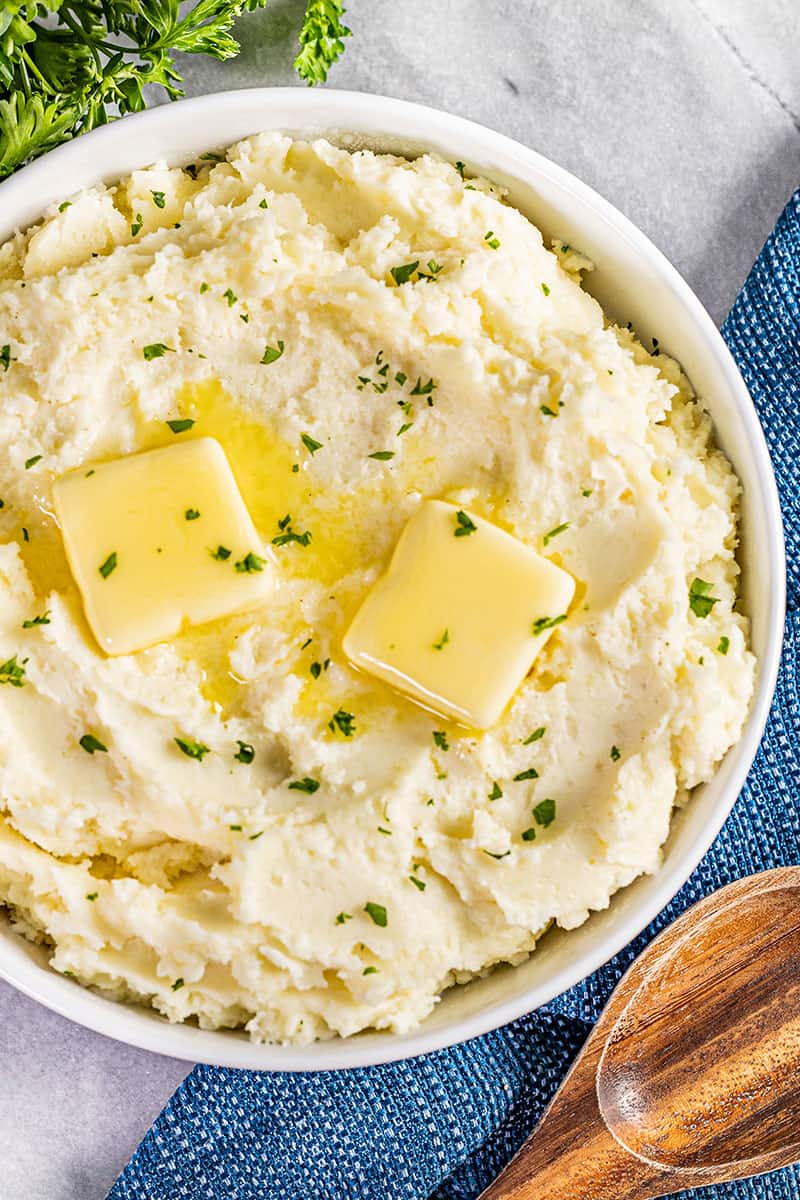
I have you cook the potatoes in chicken broth to pack in flavor before you ever add a thing. If you’ve ever ended up with gluey or sad mashed potatoes, don’t worry. I’ll walk you through everything step-by-step so you get smooth, fluffy mashed potatoes every time. Once you try it this way, there’s no going back.
Ingredient Notes
- Russet Potatoes: These are the classic choice for mashed potatoes. Yukon Golds will work too, but you’ll get a denser, more buttery texture. Avoid waxy varieties like red potatoes unless you’re okay with extra mashing and a slightly gummy texture.
- Chicken Broth: Use low-sodium broth or homemade stock to control salt levels. Better Than Bouillon also works great and is the most cost effective. Just follow the label directions to mix with water.
- Salted Butter: If using unsalted butter, just toss in an extra pinch of salt.
- Cream Cheese: Use full-fat for the best texture and flavor. Let it soften at room temperature for easier mixing.
- Buttermilk: Adds tang and creaminess. If you don’t have any on hand, you can make a quick substitute with 3/4 cup milk plus 2 teaspoons white vinegar or lemon juice. Let it sit for 5 minutes before using.
- Salt: Start with 1 teaspoon, but always taste and adjust at the end since broth and butter already add salt.
Potato Types Compared
Choosing the right kind of potato really matters. Here’s a quick guide to help you pick the one that works best for your taste and texture preference:
| Potato Type | Texture | Flavor | Notes |
|---|---|---|---|
| Russet | light, fluffy | mild, classic | Best for super creamy mashed potatoes. Absorbs butter and cream well. |
| Yukon Gold | dense, creamy | rich, buttery | Great for a richer mash with a naturally golden color. |
| Red | waxy, dense | slightly sweet, earthy | Can be used, but harder to get smooth. Best if you like some texture. |
Russets are our go-to for classic mashed potatoes, especially when you’re adding in butter and cream. Yukon Golds are a great second choice if you want something naturally a little richer and denser. If you like more texture or plan to leave the skins on, red potatoes can work, but they’ll take more mashing to get close to creamy.
The Science of Mashed Potatoes
Getting perfectly creamy mashed potatoes isn’t just about mashing and adding butter. There’s real science behind how to get that ideal, fluffy texture without going gummy.
Starch Breakdown and Why It Matters
Potatoes contain two main types of starch: amylose and amylopectin. High-starch potatoes like Russets have more amylose, which helps them break down easily and absorb butter and cream well. This is why Russets make the fluffiest mashed potatoes.
But there’s a catch: if you overmix cooked potatoes, especially with high-speed tools like food processors, you burst the cell walls and release too much starch. That excess starch turns sticky fast, which leads to the dreaded gluey texture. The more you mix, the worse it gets.
Use high-starch potatoes like Russets or Yukon Golds.
Drain them well after boiling to remove excess water.
Mash gently with a masher, ricer, or hand mixer on low. Skip the food processor or stand mixer.
The Role of Fat: Coating Starch for Creaminess
Fat plays a key role in how creamy your mashed potatoes turn out. Butter, cream cheese, and buttermilk don’t just add richness—they help coat the starch molecules and create a smoother texture.
Butter melts into the potatoes and enhances flavor while softening the texture.
Cream cheese adds body and tang, and its creamy consistency helps bind everything together without making the potatoes runny.
Buttermilk adds acidity, which balances the richness and helps cut through the starch for a lighter, fluffier feel.
The balance of fat to starch is what separates average mashed potatoes from the kind people go back for seconds on.
Temperature Also Matters
Adding cold dairy straight from the fridge can cause your potatoes to seize up. It’s best to:
- Let your cream cheese soften at room temperature.
- Warm your buttermilk slightly before adding.
- Mix in the butter while the potatoes are still hot so it melts evenly.
When the fat stays emulsified and the starch stays intact, you get smooth, creamy mashed potatoes with just the right amount of structure.
Flavor Variations
Once your potatoes are mashed, you can stir in all kinds of extras to change up the flavor. A handful of shredded cheddar and some chopped chives gives you a classic loaded potato vibe. Crumbled bacon is always a hit, and you can even replace a few tablespoons of butter with bacon grease for more depth.
If you want something herby, try mixing in fresh dill, rosemary, or thyme. Garlic is always welcome. Roasted garlic adds a mellow sweetness, or you can use garlic powder in a pinch. Parmesan or pesto will both add a punch of umami, and for something a little different, sautéed red bell pepper or browned Italian sausage brings color and richness.
You can mix and match, but we recommend keeping it simple. Choose one or two add-ins that play well together, taste, and adjust from there. The base is already packed with flavor, so a little goes a long way.
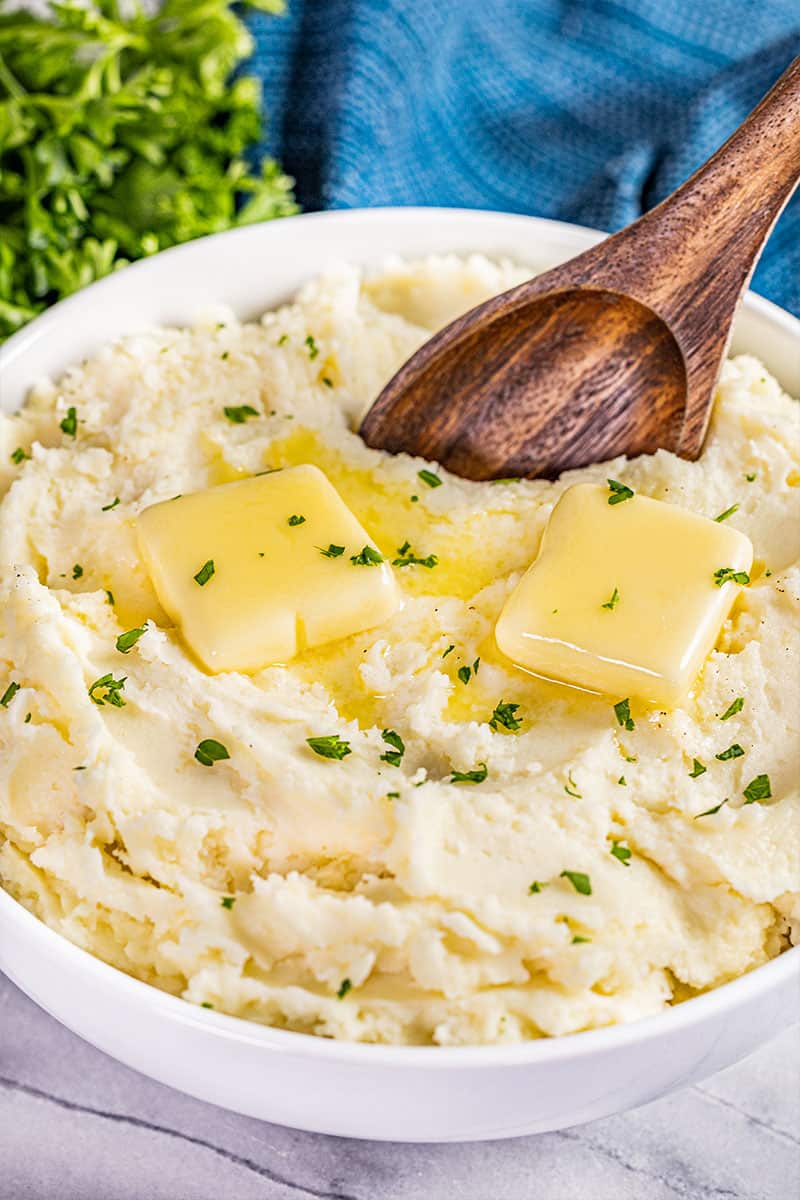
Why Chicken Broth?
Your potatoes will absorb some of the liquid that they are cooked in. Cooking your potatoes in chicken broth infuses your potatoes with flavor. You can use homemade chicken stock, chicken broth, bouillon cubes, or Better Than Bouillon.
For a vegetarian option, use vegetable stock.
When draining the potatoes, you can reserve the broth for a potato soup, but just remember that the broth will be very starchy.
FAQ/Troubleshooting
Lumps usually mean the potatoes weren’t fully cooked. Undercooked pieces won’t mash down properly. Make sure a fork slides easily through the potatoes before draining. If you already mashed and it’s lumpy, add a tablespoon or two of warm milk or cream and return the pot to low heat. Stir gently until the lumps soften, then mash again.
This happens when the potatoes are overmixed, especially with a food processor or stand mixer. Stick with a masher, ricer, or hand mixer on low speed. And don’t overdo it. You want to mash just until smooth.
They should be smooth, fluffy, and hold their shape on a spoon without being stiff. Think creamy with a light structure—not runny, not dense.
Yes! Swap the butter for plant-based butter and use plain unsweetened non-dairy milk in place of buttermilk. Add 1 teaspoon of lemon juice or vinegar to mimic that tang. Use a vegan cream cheese alternative, but expect a slightly different texture.
You can. Use the pressure cook setting for 10 minutes on high pressure with broth and potatoes. Quick release, then proceed with mashing and adding your mix-ins as usual.
Yes, but results can vary. Let them cool completely, then portion into airtight containers or freezer bags. Reheat gently with added butter and milk to bring back the creamy texture.
Mashing Tools Compared
The tool you use to mash your potatoes plays a big role in the final texture. Here’s what to know so you can choose the best one for your kitchen and your preferences.
Potato Masher: A masher gives you a rustic texture with a little more body. It’s great if you like your mashed potatoes with some small bits of potato left in. Use a classic grid-style or wave masher, and make sure your potatoes are fully cooked for the best results.
Potato Ricer: For ultra-smooth, fluffy mashed potatoes, a ricer is the gold standard. It presses the potatoes through tiny holes, which prevents lumps without overworking the starch. If you’ve ever had mashed potatoes in a high-end restaurant, they were probably riced.
Hand Mixer: This is my go-to for a creamy, whipped texture that’s still soft and light. Use it on low speed and stop as soon as the mixture is smooth to avoid gummy potatoes. It’s faster than a masher and easier to clean up than a ricer.
Tools to Avoid: Skip the blender or food processor. These high-speed tools can destroy the potato cell structure and release too much starch, giving you a sticky, gluey mess. No amount of butter can fix it.
Make Ahead Options
Day Before: You can make these mashed potatoes a day ahead. Once they’re fully prepared, let them cool slightly, then transfer to a baking dish or slow cooker insert. Cover tightly and refrigerate. When you’re ready to reheat, add a tablespoon or two of milk or a few pats of butter on top to revive the creaminess. Cover with foil and bake at 325 degrees Fahrenheit for 30 to 40 minutes, stirring halfway through.
Day Of: These mashed potatoes can also be made ahead and kept warm in a crockpot for up to 4 hours. Once mashed, transfer them to your slow cooker and set it to low or warm. Give them a quick stir every hour or so to keep them smooth. This is especially helpful during busy holiday meals when oven space is limited. You can also make them the day before. Let them cool slightly, then cover and refrigerate. Add a splash of milk or a few pats of butter before reheating.
Storage & Reheating
Refrigerate leftover mashed potatoes in an airtight container for up to 5 days.
To Freeze, let the mashed potatoes cool completely, then freeze in airtight containers or freezer bags for up to 2 months. Flatten the bags to save space and help them thaw more evenly.
Microwave Reheating: Reheat individual portions in the microwave in 30-second increments, stirring in between until warmed through. Add a teaspoon or two of milk or a pat of butter if they seem dry.
Oven Reheating: For larger portions, place the mashed potatoes in an oven-safe dish. Cover with foil and bake at 325 degrees Fahrenheit for 30 to 40 minutes, stirring halfway through. Add butter or milk as needed to restore the creamy texture.
Serve these potatoes with…
Watch the video below where Rachel will walk you through every step of this recipe. Sometimes it helps to have a visual, and we’ve always got you covered with our cooking show. You can find the complete collection of recipes on YouTube, our Facebook Page, or right here on our website with their corresponding recipes.
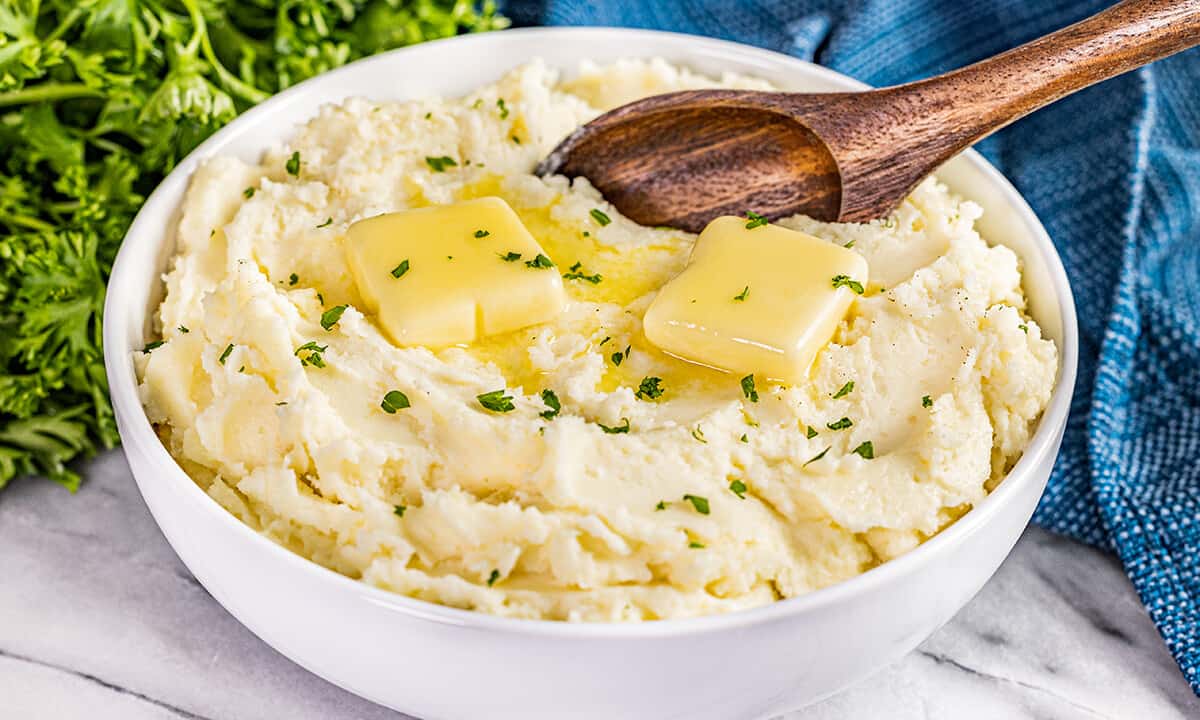
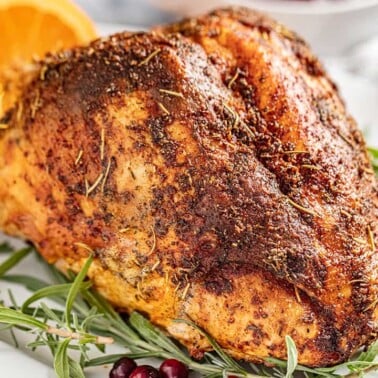
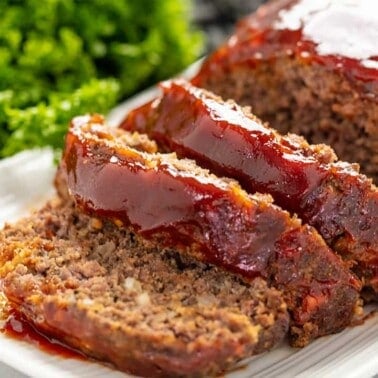
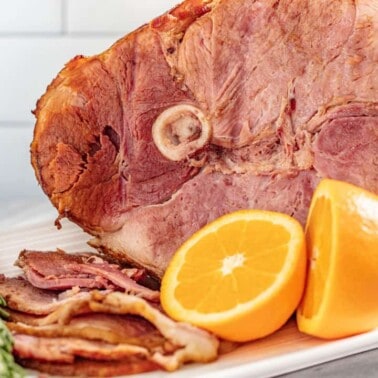
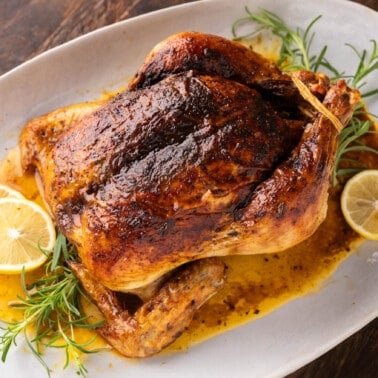
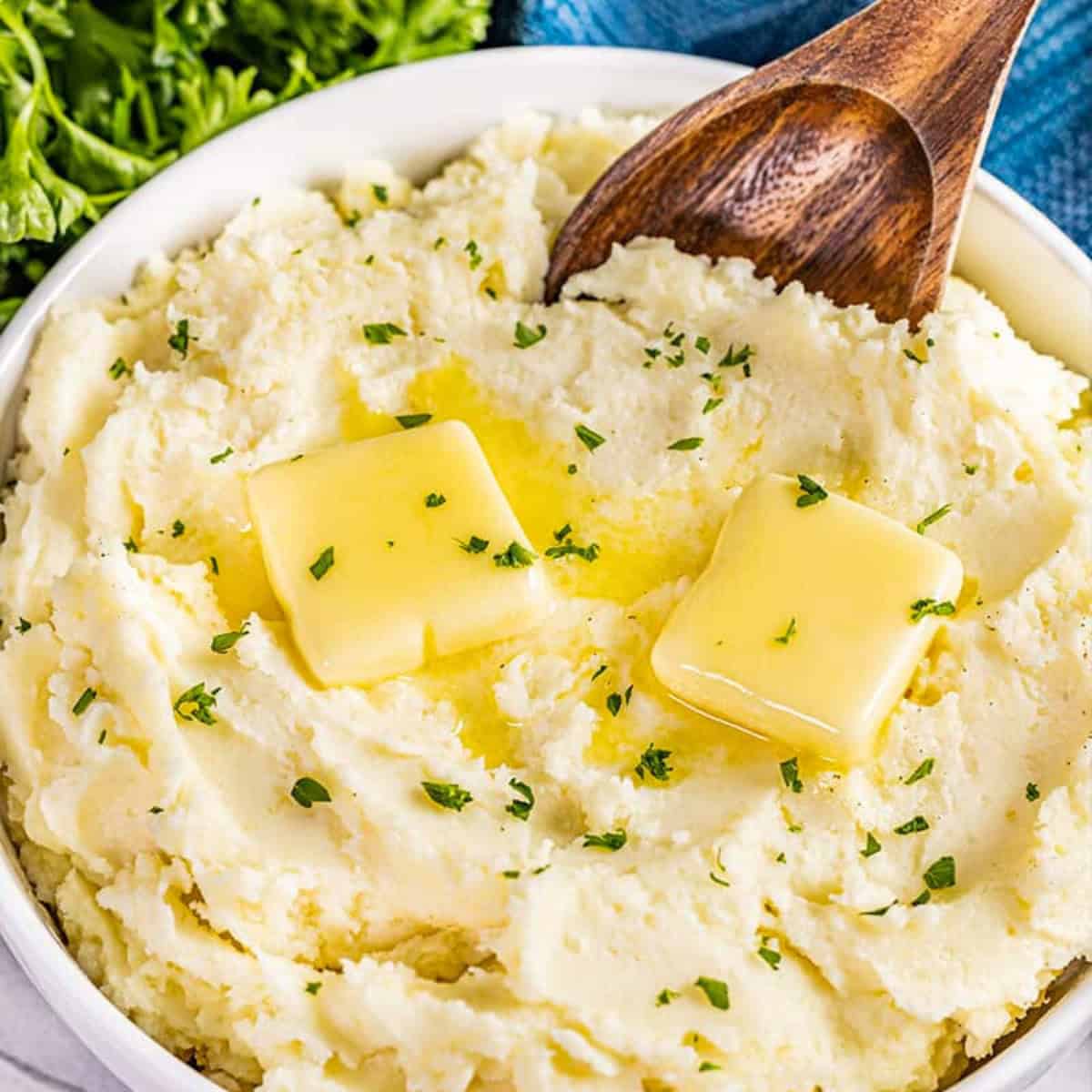
Could I use chicken bone broth and would it increase the protein to do so ?
You can absolutely use bone broth. It won’t really increase the protein content though.
THESE WERE AMAZING! My mashed potatoes are usually lumpy, but this time were so silky smooth! I will make these again and again!
Save the liquid from the potatoes to use to make gravy or to make any type of soup or for bone broth.
Fabulous!
I made these today and they were heavenly! These will definitely be my go-to for mashed potatoes 😊
Can I use Heavy whipping cream
You definitely could. It will be very rich.
Can I use reg milk
Yes you can. It just won’t be quite as rich.
I just love your recipes, I will be making these for the first time for my Thanksgiving Family Dinner. You and your team are the best! Happy Holidays 😊
I just love your recipes, I will be making these for the first time for my Thanksgiving dinner family dinner. You and your team are the best! Happy Holidays 😊